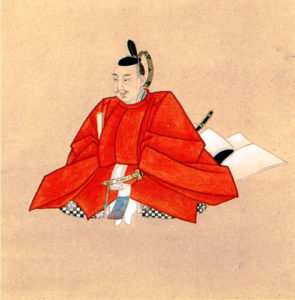
Sen no Rikyū, the most famous master of the Japanese Tea Ceremony, taught his disciples to “do things differently”.
Most of them either kept doing the same, or just changed minor details in their practice of the tea ceremony.
But Furuta Oribe (古田 織部) developed an artistic taste so boldly different from the somber Raku ware of Rikyū, that even now the Oribeyaki style of pottery is still popular in Japan.
The life of Furuta Oribe
His birth name was Furuta Shigenari.
He was born in present day Motosu city, Gifu Prefecture, 1544.
Oribe’s father was Furuta Shigesada, a military commander.
According to a written account, Oribe disliked the tea ceremony when he was young.
At age 17 he served under Oda Nobunaga, a powerful feudal lord.
After Nobunaga was succeeded by Toyotomi Hideyoshi, Oribe fought another number of battles for him as well.
In 1585, Hideyoshi gave him a higher court rank and the name Oribe, as a recognition for his accomplishments as a military commander.
Until his forties, there are no mentions of Oribe as a practitioner of the tea ceremony.
Oribe married Sen, the sister of Nakagawa Kiyohide, lord of Ibaraki.
While there isn’t definite proof that Oribe was a direct pupil of Sen no Rikyū, it is very likely.
Oribe is remembered in histoy as one the seven most important disciples of Rikyū.
There are many letters written by Rikyū where he shows fondness for Oribe.
After Rikyū was ordered by Hideyoshi to commit suicide, Oribe became the most important tea master in Japan.
In the year 1600, he took part in the Eastern Army (forces of Tokugawa Ieyasu) at the battle of Sekigahara.
He received a high income and more status as a reward.
Oribe also taught the tea ceremony to the shogun Tokugawa Hidetada.
Oribe as a tea master
He founded the Oribe school of the tea ceremony, which is still active today. This is one of the warrior styles of the tea ceremony.
For example, while Rikyū preferred to leave social status out of the tea room, Oribe enforced it.
He showed great genius in the designs of his teaware and utensils.
Oribe created warped bowls and irregular shapes on purpose. That must have been very bold in his time.
400 years later his work looks as if it was made recently. As an artist, Oribe was quite ahead of his time.
Nowadays, Oribe ware is still made in Japan.
Oribe had many pupils, the most famous being Kobori Enshū.
The last days of Furuta Oribe
In 1615 one of Oribe’s vassals, Kimura Soukin, planned an attack on the Tokugawa.
Oribe was ordered to commit suicide as a result, although it was unlikely that he had taken part in that plan. His eldest son and 24 of his vassals also suffered the same fate.
Furuta Oribe was 73 years old at the time.
